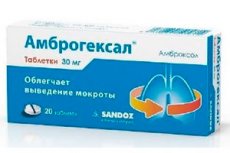新出版物
Ambrohexal
阿列克谢·克里文科,医学审稿人
最近審查:04.07.2025
最近審查:04.07.2025

氨溴索(商品名:安溴索)是一种用于促进呼吸道黏液和分泌物排出的黏液溶解剂。它有助于稀释黏液并改善黏液排出,从而缓解上、下呼吸道疾病引起的咳嗽,例如支气管炎、气管炎、支气管哮喘、阻塞性肺病 (OPD)、支气管扩张以及其他伴有呼吸道黏液形成和滞留的疾病。
適應症 安布罗黑沙拉
- 急性和慢性支气管炎
- 肺炎
- 慢性阻塞性肺病(COPD)
- 支气管哮喘伴有咳痰困难
- 支气管扩张
- 囊性纤维化
發布表單
氨溴索有多种剂型,例如:
- 药丸。
- 糖浆。
藥效學
粘液溶解作用:
- 氨溴索可稀释粘液,降低其粘度,使其更容易咳出。
- 这是通过影响痰液的粘蛋白和粘多糖以及刺激水解酶和增加表面活性剂的产生来实现的。
祛痰作用:
- 氨溴索能增加呼吸道上皮纤毛的运动活性,从而促进更有效地从呼吸道中清除痰液。
抗炎作用:
- 氨溴索具有温和的抗炎作用,可减轻呼吸道炎症并减少刺激。
藥代動力學
吸:
- 口服吸收:口服后,氨溴索迅速且几乎完全从胃肠道吸收。
- 生物利用度:由于肝脏的首过效应,口服后的绝对生物利用度约为70-80%。
分配:
- 血浆蛋白结合:该药物与血浆蛋白结合率约为90%。
- 组织分布:氨溴索在组织中分布良好,尤其是在肺部,这确保了其对呼吸道的靶向作用。
- 分布容量:约552升。
代谢:
- 肝脏代谢: 氨溴索在肝脏中代谢,主要通过结合作用转化为无活性的代谢物。
- 主要代谢物:二溴邻氨基苯甲酸和葡萄糖醛酸苷。
提款:
- 尿液排泄:约90%的氨溴索以代谢物形式经尿液排出。不足10%的氨溴索以原形排出。
- 半衰期:氨溴索的半衰期约为10小时。
特殊患者群体:
- 肾功能损害:对于严重肾功能损害的患者,氨溴索代谢物的消除可能会延迟。
- 肝功能不全:肝功能不全的患者,氨溴索的代谢可能会变慢,可能需要调整剂量。
劑量和管理
氨溴索的剂量可能因患者的年龄和病情严重程度而异。但对于成人和12岁以上儿童,通常建议剂量为每日2-3次,每次30毫克。对于6至12岁的儿童,通常建议剂量为每日2-3次,每次15毫克。对于2至6岁的儿童,建议剂量为每日3次,每次7.5毫克。
该药物在用餐时服用,并伴随足量的液体(例如水)。
在懷孕期間使用 安布罗黑沙拉
效率与安全
- 促进胎儿肺成熟:研究表明,氨溴索可通过增加表面活性物质的产生来促进胎儿肺成熟,从而降低早产儿患呼吸窘迫综合征 (RDS) 的风险。一项研究发现,氨溴索与倍他米松一样有效,但副作用更小 (Wolff 等人,1987)。
- 预防呼吸窘迫综合征:多项研究已使用氨溴索预防早产儿呼吸窘迫综合征。结果表明,与安慰剂相比,氨溴索降低了呼吸窘迫综合征的发病率,证实了其在该领域的有效性(Wauer等人,1982年)。
- 抗氧化活性:氨溴索还具有抗氧化特性,有助于降低包括胎盘在内的组织中的氧化应激。这可能有助于减少妊娠期间与氧化应激相关的并发症 (Chlubek 等人,2001)。
- 副作用和安全性:大多数研究发现,使用氨溴索对母亲或新生儿均无显著不良反应。一项比较氨溴索与倍他米松的研究发现,两组不良反应发生率无显著差异(Gonzalez Garay 等人,2014)。
- 剂量和用法:在大多数研究中,氨溴索的给药剂量为每天 1000 毫克,持续 5 天,发现可有效刺激胎儿肺成熟并降低 RDS 风险(Vytiska-Binstorfer 等人,1986 年)。
禁忌
- 对氨溴索或该药物的任何其他成分过敏或过敏反应。
- 上呼吸道长时间出血或肺出血。
- 与呼吸道上皮纤毛活动受损相关的疾病(例如支气管哮喘或慢性阻塞性肺病)。
- 怀孕(特别是在妊娠前三个月)和哺乳(此期间的安全数据有限,因此只能出于医疗原因并在医生的监督下使用)。
- 2 岁以下儿童(片剂形式)。
副作用 安布罗黑沙拉
- 胃肠道疾病:腹泻、恶心、呕吐、胃部不适。
- 味觉障碍。
- 过敏反应:荨麻疹、瘙痒、血管性水肿、过敏性皮炎。
- 肝功能障碍。
- 头痛、虚弱、出汗增多。
過量
过量服用氨溴索可能会增加副作用,如恶心、呕吐、头痛、唾液腺和呼吸道粘膜分泌增加。
與其他藥物的相互作用
主要相互作用:
镇咳药:
- 止咳药(例如可待因):
- 与镇咳药同时使用可能会导致咳痰困难,因为抑制咳嗽反射会导致痰液在呼吸道中停滞。
- 止咳药(例如可待因):
抗生素:
- 阿莫西林、头孢呋辛、红霉素、强力霉素:
- 氨溴索可增加这些抗生素在支气管分泌物和痰液中的浓度,从而增强其治疗呼吸道感染的效果。
- 阿莫西林、头孢呋辛、红霉素、强力霉素:
茶碱:
- 茶碱:
- 氨溴索与茶碱合用可能导致血中茶碱浓度升高,增加毒性风险。合用时需监测茶碱血药浓度。
- 茶碱:
非甾体抗炎药(NSAID):
- 非甾体抗炎药:
- 同时使用可能会增加胃肠道刺激和胃酸分泌增加的风险。同时服用时需谨慎。
- 非甾体抗炎药:
特别说明:
酒精:
- 饮酒可能会增加氨溴索对胃粘膜的刺激作用,从而增加副作用的风险。
影响肝功能的药物:
- 影响肝功能的药物可能会改变氨溴索的代谢,因此一起使用时需要谨慎。
其他粘液溶解剂:
- 与其他粘液溶解剂同时使用可能会增强粘液稀释效果,这可能是有益的,但需要对整体治疗方案进行评估。
注意!
為了簡化對信息的理解,本指令使用了藥物 "Ambrohexal",並根據藥物的醫療用途官方說明。 使用前請閱讀直接用於藥物的註釋。
描述僅供參考,不適用於自我修復指導。 這種藥物的需求,治療方案的目的,藥物的方法和劑量僅由主治醫師確定。 自我藥療對你的健康有危害。

